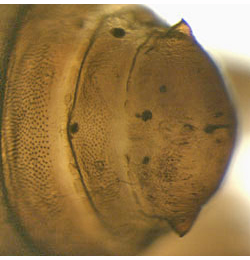|
||||||
|
LARIX. Larches. [Pinaceae] |
|
Five species and subspecies of Larix are recorded in Britain. The BSBI provide a downloadable plant crib for conifers. Three British miners are recorded on Larix. A key to the European miners recorded on Larix is provided in Bladmineerders van Europa. |
|
Key for the identification of the known mines of British |
1a > Leaf-miner and case-bearer: The larvae feed on the needles. When occurring in large numbers, entire trees can be damaged, the needles turning pale as the larvae eat them from within. A number of cases are built as the larvae grow, often in the centre of a floret of needles. |
 Coleophora laricella larva, dorsal Image: © Willem Ellis (Bladmineerders van Europa) |
|
Coleophora laricella (Hübner, 1817) [Lepidoptera: Coleophoridae]. |
1b > Leaf-miner, but not a case-bearer |
2a > Leaf-miner: The larva feeds inside the apical part of the needle in the autumn and ejects most of the frass from holes at either end of the mine. After hibernation it then feeds on spun needles and shoots. The larva enters the needle at about three quarter of its length, at the flat side; the opening is closed with silk (picture above). From here the larva mines upwards (rarely also a small distance downwards).The larva lives in a spacious larval chamber in the lowest part of the mine, lined with stripes of dense spinning. The frass is accumulated in the apical part of the mine. Sometimes one, more rarely two, openings are made to eject part of the frass; these openings too are closed with silk, and are difficult to find. No egg shell is visible at the start of the mine. The larva hibernates in the mine; in the following spring it feeds on the shoots and in spun needles (Hering, 1957a). Pupation external, in a bud (Freeman, 1960a).. |
|
Exoteleia dodecella (Linnaeus, 1758) [Lepidoptera: Coleophoridae]. |
2b > Leaf-miner: In Belgium the larva feeds at first between some needles of Larix spun together. It has been observed also on Picea sitchensis. After hibernation it feeds in the expanding buds. Pupation in the larval feeding place (Belgian Lepidoptera). In late summer the larva spins a few needles together, and mines them out. The larva hibernates between some mined needles that haven been spun together. After hibernation the larva bores into a developing bud, eventually pupating there. |
|
Spilonota laricana (Heinemann, 1863) [Lepidoptera: Tortricidae]. |
| Last updated 26-Jun-2019 Brian Pitkin | ||
